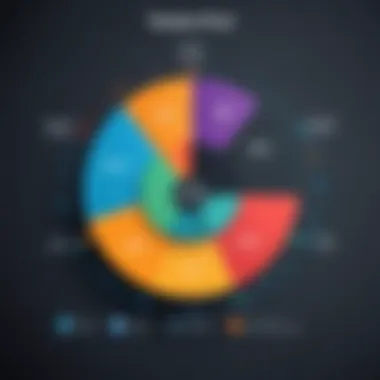Understanding Taboola Costs: A Detailed Analysis


Intro
As digital advertising continues to evolve, understanding the underlying costs associated with various platforms has become crucial for business owners and decision-makers. One such platform that has gained considerable traction is Taboola. This article will dissect the financial nuances of utilizing Taboola for advertising. It aims to provide you with an intricate examination of its cost structures — encompassing bidding models, average spends, and the various factors that influence pricing strategies, drawing comparisons to alternative advertising networks.
Software Category Overview
Definition and Importance
Taboola operates within the realm of native advertising. Unlike traditional banner ads or pop-ups, native ads blend seamlessly into the content a user is engaging with, making them less intrusive and potentially more effective. The importance of understanding this platform lies in its ability to drive significant traffic through content discovery while maintaining a user-friendly experience. As companies look for ways to engage customers, a firm grasp of costs and expected returns on platforms like Taboola becomes essential.
Key Characteristics
Taboola is characterized by its innovative content recommendation engine designed to attract user attention and drive clicks. It operates under a pay-per-click (PPC) model, which means advertisers pay only when users engage with their content. Key characteristics of Taboola include:
- Targeting Capabilities: Advertisers can reach specific demographics based on user interests and behaviors, enhancing the relevance of their campaigns.
- Scalability: The platform caters to both large enterprises and small businesses, making it accessible for various budgets.
- Performance Metrics: Taboola provides detailed insights and analytics, helping advertisers optimize their strategies based on real-time data.
Comparative Analysis of Top Software Options
Feature Comparison
When considering Taboola as part of your digital strategy, it’s important to compare its features against those of other platforms, such as Outbrain or Facebook Ads. While all these platforms aim to deliver ads to users, their approaches vary:
- Taboola: Focuses on content discovery and user engagement through native advertising.
- Outbrain: Similar to Taboola but often configured for different advertiser objectives, emphasizing editorial placement.
- Facebook Ads: A broader social media advertising approach that includes various ad formats and placement options.
Pricing Models
Pricing models can significantly impact the overall cost of a campaign. Taboola uses a few different models, including:
- CPC (Cost Per Click): Advertisers pay each time a user clicks their ad, aligning costs directly with engagement.
- CPE (Cost Per Engagement): A model where costs are tied to specific interactions, which may include video views or additional engagement metrics.
Understanding these models allows businesses to strategize their budgeting effectively. For instance, analyzing the average spending in these models can help project potential ROI.
"Effective budgeting and understanding of ad costs can transform how businesses engage with digital advertising, leading to better returns."
In summation, dissecting the cost structures, evaluating competitor platforms, and recognizing the intricacies of the advertising landscape empowers decision-makers with the critical insights necessary to maximize their marketing budgets.
Intro to Taboola
In the ever-evolving landscape of digital advertising, understanding the tools at your disposal is crucial for achieving success. This article aims to shed light on Taboola, a platform that has gained traction among businesses keen on maximizing their online presence. Taboola serves as a gateway to potential customers by providing tailored content recommendations, making it a prominent player in the realm of native advertising.
What is Taboola?
Taboola is essentially an advertising platform designed to drive traffic through personalized content recommendations. Think of it as a bridge connecting advertisers with their desired audience via engaging and relevant content. Users often encounter Taboola's suggestions at the bottom of articles or on various content websites, nudging them to explore more information that aligns with their interests.
This model doesn’t just help advertisers; it also enhances the user experience by presenting content that resonates with individual preferences. Whether you're promoting a blog post, a product, or a service, Taboola provides a bespoke avenue to reach potential customers who are likely to engage with your offerings.
Overview of Taboola's Services
Taboola offers a suite of services that cater to different advertising needs. Among the most notable are:
- Content Discovery: This feature directs users to discover content that they might have otherwise missed. By analyzing user behavior, it suggests articles, videos, or other forms of media relevant to the interests of individual users.
- Targeted Advertising: Leveraging deep data analytics, Taboola allows businesses to target specific demographics. You can narrow down your audience based on various criteria, such as location, age, or even browsing habits.
- Performance Tracking: Taboola provides robust analytics tools that equip advertisers to monitor their campaigns' performance. You can track metrics, including views, clicks, and conversions, giving you a crystal clear vision of how your advertising dollars are performing.
The beauty of Taboola lies in its flexibility. Businesses, big or small, can adapt their advertising strategies to fit their needs. As a platform that thrives on user engagement, Taboola offers valuable insights that can enhance the effectiveness of your marketing efforts. With all these services in the mix, it’s clear that Taboola plays an indispensable role in contemporary digital marketing strategies.
Cost Structure of Taboola Advertising
Understanding the cost structure of Taboola advertising is essential for businesses seeking to maximize their return on investment. This section unpacks the various mechanisms through which you can engage with the platform effectively. The cost structure is not merely about money; it encompasses strategic placement, audience targeting, and your overall marketing goals.
The significance of grasping these elements lies in the advantages it confers: the ability to tailor your advertising spend to align with business objectives, ultimately driving desired outcomes such as increased traffic, engagement, or conversions. Moreover, familiarity with the cost structure aids in navigating the competitive landscape of digital advertising, ensuring that your campaigns are both efficient and impactful.
Pricing Models Explained
In this segment, we’ll dive into Taboola's various pricing models. Each model serves a unique purpose and influences budget allocation in distinct ways.
Cost Per Click (CPC)


CPC is one of the most straightforward models. Advertisers pay a fee each time someone clicks on their ad. This model is popular because it directly correlates spending with user engagement. If you're an advertiser focused on driving traffic, this may be a solid choice. One key characteristic of CPC is that it allows for immediate feedback on performance. If clicks are low, you can tweak your ads in real time.
One unique feature of CPC is its flexibility. You only pay when someone shows interest, which can make budgeting simpler. However, it must be noted that high competition in your niche can skew CPC rates, sometimes driving costs up unexpectedly.
Cost Per Mille (CPM)
In contrast to CPC, CPM requires advertisers to pay for every 1,000 impressions their ad gets, regardless of whether anyone clicks on it. This model can benefit businesses focused on brand awareness rather than immediate clicks. The essential characteristic of CPM is that it allows for easy scaling once a campaign shows effectiveness. You can reach a wider audience with a stable budget.
The unique feature of CPM is its predictability—a fixed cost that does not fluctuate with engagement levels. However, it can lead to wasted expenditure if your ads are not appealing, thus generating low click-through rates, which could be problematic if you're not mindful of your content quality.
Cost Per Action (CPA)
CPA takes engagement a step further by charging advertisers only when a user completes a desired action, such as signing up or making a purchase. This model is highly beneficial for those who have a clear metric of conversion to track. The main characteristic of CPA is that it aligns spending with tangible outcomes.
What sets CPA apart is its performance-based approach, optimizing return on investment significantly. However, it may require a robust ad strategy and higher initial costs to properly set up campaigns, making it crucial to monitor performance closely.
Factors Affecting Cost
When budgeting for Taboola campaigns, various factors play a role in determining spending. Knowledge of these factors can help you fine-tune your strategy.
Target Audience
The target audience is crucial when considering advertising costs on Taboola. Different demographics carry different costs, based on demand and competition. A noteworthy characteristic here is that specific audiences may yield higher returns, which justifies the higher expenditure.
Understanding your audience can lead to cost-effective campaigns. However, failure to precisely identify and target the right users can lead to overspending and low results, negatively impacting returns.
Content Quality
The quality of your content significantly influences costs on Taboola. High-quality content tends to generate more organic engagement, leading to better performance and lower costs per engagement over time. One key point is that well-crafted content is more likely to be shared, amplifying its reach.
However, the production of high-quality content often comes with a higher upfront investment, which could deter some businesses from fully committing. Ignoring content quality can lead directly to wasted ad budget and diminishing returns.
Geographic Targeting
Geographic targeting is another aspect to consider. The cost may fluctuate based on the location you wish to target. A major characteristic of geographic targeting is its ability to align ads with local market demands. This tailored approach can enhance your effectiveness and optimize spend.
The unique factor here is that certain regions may command higher rates, yet they could also yield higher engagement. Finding the right balance in geographical targeting requires careful analysis of your target audience and market competition, as it could also lead to overspending if not approached wisely.
Understanding these aspects contributes to more effective budgeting, ensuring you get the best value for your marketing spend.
Average Costs Associated with Taboola
Understanding the average costs when advertising through Taboola is crucial for businesses aiming to maximize their promotional efforts. It helps in painting a clearer financial picture while navigating this native advertising landscape. Cost insights not only allow for more strategic budget allocation but also establish a reasonable expectation of the return on investment from campaigns. With digital advertising evolving rapidly, grasping these cost elements can significantly influence decision-making processes, ensuring that marketing dollars are spent wisely.
Typical CPC Rates
In the realm of online advertising, Cost Per Click (CPC) stands as one of the key pricing models employed by Taboola. Typically, CPC rates can vary significantly, landing anywhere from a few cents to several dollars per click, depending largely on several influencing factors such as industry competition and target demographics. Small businesses may find themselves paying around $0.10 to $0.50 per click, while more competitive sectors, such as finance or technology, might see rates soar to $2 or beyond.
- Factors Influencing CPC Rates
- Competition: If many advertisers are targeting the same audience, expect higher costs.
- Quality Score: Higher-quality ads may lead to discounted rates.
- Industry Variability: Some industries are simply more expensive than others, reflecting market demand.
A careful analysis of CPC allows businesses to predict costs more accurately and align them with potential outcomes. The idea is to cultivate a strategy that maintains costs in check, balancing it against anticipated engagement and conversion.
Comparative Analysis of CPM
Cost Per Mille, or CPM, is another pivotal metric worth considering. On average, CPM rates through Taboola hover around $5 to $30. This model charges advertisers for every thousand impressions, throwing a light on how pricing can differ based on various content types and audience specifics.
- Understanding CPM
- Content Quality Matters: High-quality, engaging content tends to deliver better performance, often resulting in lower CPM.
- Audience Targeting: More specific targeting generally raises CPM due to higher demand for that audience segment.
Comparing Taboola’s CPM with other platforms sheds light on its competitive position in the market. This model can be particularly advantageous when aiming for extensive reach in campaigns. However, it’s vital to ensure that a comprehensive tracking system is in place to gauge the effectiveness of each impression.
Understanding CPA Metrics
Cost Per Action (CPA) is a compelling metric, as it provides insights into the actual outcomes of ad campaigns. Unlike CPC or CPM, CPA focuses on actions taken by users after clicking on an ad—be it signing up for a newsletter or making a purchase. Typical CPA rates can vary widely based on factors like industry and audience but often land between $10 and $50.


The importance of CPA cannot be overstated:
- True Performance Indicator: CPA shows the effectiveness of ad spending in terms of actions taken rather than just click or impression counts.
- Optimization Potential: Businesses can continually optimize their campaigns, honing in on what actions yield results, thus refining their advertising tactics.
Budgeting for Taboola Advertising
When it comes to leveraging Taboola for advertising, the importance of budgeting cannot be overstated. In the dynamic realm of digital marketing, having a clear and well-structured budget allows decision-makers to maximize their investments and ensure that their advertising efforts yield significant returns. This section will dive into pivotal aspects of budgeting, covering the nuances involved in setting an advertising budget and allocating resources efficiently.
Setting an Advertising Budget
Establishing an advertising budget is the first step in making sure that your Taboola campaigns are focused and effective. Without this, you might find yourself navigating through murky waters, unsure of where your funds are going or how to best utilize them. Think of your budget as a financial compass—it guides every decision and strategy you employ.
- Determine Your Overall Marketing Budget: The first thing to do is to have a grasp of your total marketing budget. This acts as a foundation to decide how much you can afford to allocate to Taboola. Consider everything from existing expenses to anticipated returns.
- Identify Your Key Objectives: What do you want to achieve with your advertising? Whether it’s increasing brand awareness, generating leads, or driving sales, defining your goals clearly will help in prioritizing your budget allocation effectively.
- Analyze Historical Data: If you’ve run campaigns before, dive into your historical performance data. Identifying what has worked and what hasn’t can provide clarity on how to distribute your budget smarter in future campaigns.
By spending time to set a solid advertising budget upfront, you can position your campaigns to be not just financially sound but aligned with your larger business goals.
Allocating Resources Effectively
Once a budget is set, the next step is resource allocation. Think of your budget as a pie; if you can slice it just right, you’ll have the perfect pieces to fill your marketing needs. Allocating your resources effectively involves both time and money. Here are a few points to consider:
- Content Quality: The ad creatives that you put out on Taboola will play a critical role in drawing in clicks. Ensuring that a portion of your budget is earmarked for high-quality content is essential, as this can impact performance significantly.
- Audience Targeting: Good targeting can lead to efficient ad spending. Make sure to allocate funds to advanced targeting options that reach the right demographic for your product or service. Consider allocating a portion of your budget for A/B testing different audience segments.
- Time Management: Allocating human resources is equally vital. If you have a team dedicated to monitoring and optimizing your campaigns, ensure they have the tools and time necessary to analyze performance data and tweak strategies as necessary.
Remember: Just as the right ingredients create the best dishes, the right allocation of resources creates the best advertising outcomes.
When these elements are harmonized, your budget won’t just be numbers on a spreadsheet; it will come alive, propelling your Taboola campaigns to meet and exceed expectations. Adequate budgeting and resource allocation stand as pillars in the journey toward successful advertising endeavors.
Return on Investment (ROI) Considerations
Understanding ROI when using Taboola for advertising is like having a roadmap. It's more than just a number; it's a reflection of the effectiveness of your advertising efforts. Let's delve into the essential elements of ROI and why it matters, particularly for decision-makers, entrepreneurs, and IT professionals who seek to maximize their investment outcomes.
Measuring Ad Performance
Measuring ad performance starts with defining clear metrics. You can’t hit a target you don’t have in sight. Key Performance Indicators (KPIs) such as clicks, conversions, and engagement rates help you gauge how well your ads are performing on Taboola. A common approach is to set your baseline metrics before your campaign begins. For example, if your goal is to achieve a 5% click-through rate, use that as a benchmark.
Then, as your campaign runs, continually monitor data. Taboola provides detailed analytics that can inform you how much traction your content is gaining. The beauty of this platform lies in its real-time feedback; you might notice that certain headlines or images drive more engagement than others. Adjusting your strategy based on these insights can improve your performance significantly.
- A/B Testing is crucial. Test different headlines, images, or even targeting options. This approach aids in identifying what truly resonates with your audience, leading to improved performance in subsequent campaigns.
- Implement tracking mechanisms to accurately analyze user interactions from the moment they click through your ad until they take the desired action.
With all this data, start calculating your ROI by weighing the total revenue generated against your total advertising spend. This gives you a clear picture of how effectively your dollars are producing results.
Evaluating Long-Term Benefits
It's easy to get caught up in short-term gains, but evaluating long-term benefits is essential. While quick wins can be satisfying, sustainable success often leads to lasting growth. Paying attention to how your Taboola strategies influence overall brand awareness, customer retention, and lifetime customer value should be on your radar.
Consider keeping a customer journey map. This visual representation details all touchpoints a customer experiences with your brand. When you place Taboola ads, you create another channel through which potential customers engage with your content. Over time, you might notice that increased brand familiarity can play a major role in customer decision-making.
- Monitor Customer Retention Rates: How many customers come back to purchase after their first interaction? A rise in this metric can indicate that your initial advertising efforts are yielding dividends.
- Reassess Brand Visibility: Longer-term campaigns may enhance visibility, leading to organic referrals. You may find that a noteworthy number of your leads begin to come from customer recommendations or through social media channels.
In summary, measuring ad performance and evaluating long-term benefits while using Taboola form two sides of the same coin. By embracing both perspectives, businesses can create a far more nuanced understanding of their marketing spend, ensuring that each advertising dollar contributes toward sustainable growth.
"In this fast-paced world of advertising, the ability to think long-term can be the defining factor for success."
Keeping this in mind is crucial as you navigate the ebbs and flows of your advertising strategies.
Comparative Analysis with Other Platforms
When it comes to advertising, understanding where a platform sits in relation to others is crucial. This section delves into how Taboola stacks up against various native advertising contenders. It’s not just about what each platform offers, but also how those offerings resonate with the needs of advertisers. Evaluating Taboola’s position provides insights into its potential effectiveness and cost-efficiency compared to its peers.
Taboola vs. Other Native Advertising Platforms
Taboola isn’t working in a vacuum. It operates in a competitive landscape that includes platforms like Outbrain, Revcontent, and Sharethrough. Each of these players has their own strengths and weaknesses, impacting how advertisers engage with their respective audiences. Here are some key points of comparison:
- Targeting Options:
Taboola shines with a strong emphasis on audience targeting. It uses sophisticated algorithms to promote content that aligns with user preferences. On the other hand, platforms like Outbrain may offer fewer targeting refinements. - Ad Formats:
While Taboola specializes in native ads that blend into page content seamlessly, Sharethrough offers a range of formats, including video and in-feed ads, which can be beneficial for a diverse marketing strategy. - Cost Structure and Flexibility:
Cost-wise, Taboola has a layered approach with CPC, CPM, and CPA models. This flexibility can be a double-edged sword; it offers customizable campaigns but can also lead to potential confusion over budgeting. - Performance Metrics:
When assessing success, Taboola provides a wealth of data analytics. However, some platforms may present a simpler interface for quick metrics, which might appeal to less experienced users.
Overall, determining how Taboola fares against the competition revolves around an advertiser's specific needs, campaign types, and overall marketing goals.


Advantages and Disadvantages
Every advertising platform has its perks and pitfalls. For those leaning towards Taboola, it's pivotal to weigh both sides. Here’s a simplified breakdown:
Advantages:
- Rich Audience Targeting:
Taboola’s ability to harness data for precise audience targeting is a game changer for many businesses. By honing in on user behavior, brands can enhance their visibility among potential customers. - Diverse Content Promotion:
Taboola allows for varied content types, from articles to videos, permitting advertisers to engage users in different ways. This variability can lead to better interaction rates. - Robust Analytics:
One of the notable strengths of Taboola is its detailed performance reports. Marketers can monitor campaigns closely, adjusting strategies based on real-time data to maximize ROI.
Disadvantages:
- Cost Variability:
While flexibility in pricing is essential, the fluctuating costs can be overwhelming for new users. Without a clear understanding, advertisers might overspend or misallocate their budgets. - Learning Curve:
The complexity of some features might present a barrier for novices in digital marketing. This could necessitate a steeper learning curve compared to other platforms. - Ad Blindness Risk:
Like many tools that focus on native advertising, there's a risk that users may become desensitized to ads, affecting click-through rates. Understanding audience fatigue is key to sustaining effective campaigns.
In summary, while Taboola offers a powerful platform with substantial capabilities, balancing its advantages against the challenges it presents is essential for any discerning marketer. Thoughtful consideration of one’s campaign goals and the competition at large can lead to a more informed decision-making process regarding its use.
Insights from Industry Professionals
Understanding the cost implications of utilizing Taboola is not just about grasping pricing models and average expenditures. Engaging with insights from industry professionals can illuminate the subtleties that numbers alone may not convey. These insights often stem from real experiences and are grounded in the complexities of digital marketing. They offer a well-rounded perspective that highlights both the potential advantages and obstacles of leveraging Taboola for advertising.
Case Studies and Success Stories
Diving deeper into the practical application of Taboola, case studies present tangible evidence of its effectiveness. For instance, a mid-sized e-commerce company, after grappling with stagnation in organic reach, turned to Taboola as a part of its content discovery strategy. The company tailored its ads to resonate with the interests of specific consumer segments. Within three months, there was a remarkable 40% increase in website traffic. Moreover, the conversion rate doubled, showcasing the power of targeted advertising through Taboola.
Another inspiring example involves a travel agency which utilized Taboola to promote unique travel packages. By employing engaging visuals and tailored headlines, the agency attracted users whose browsing habits indicated a strong interest in travel. The click-through rate surged by 25%, leading to increased inquiries and bookings. Anecdotes like these not only illustrate the power of strategic use of Taboola but also offer vital lessons in targeting and content quality which are crucial for successful campaigns.
Expert Recommendations for Cost Management
When it comes to managing costs effectively in Taboola advertising, experts emphasize several key strategies that can help marketers to stretch their dollar further.
- Test and Learn Approach: Initiating campaigns with a flexible budget for testing is advisable. Small-scale experiments can reveal what resonates with your target audience without breaking the bank.
- Segmentation: Not all audiences are alike. By segmenting your target groups based on demographics or interests, you can tailor messages that closely match their preferences, ultimately boosting engagement and reducing wasted spend.
- Continuous Optimization: Using analytics tools to monitor performance can provide insights into what’s working and what isn't. This enables advertisers to pivot and adjust their strategies in real-time, ensuring that resources are allocated to the most effective ads.
- Creative Quality: Investing in quality content cannot be overlooked. Well-designed and compelling visuals paired with catchy headlines usually lead to better performance, lowering overall cost per engagement.
- Set Realistic Goals: It is essential to align advertising spend with specific, measurable outcomes. Experts advise setting KPIs that are both achievable and informative to help track effectiveness and inform future campaigns.
Challenges and Limitations
Navigating the world of advertising on Taboola can be a bit like walking through a dense fog; there are opportunities to be seized, but hidden pitfalls can also lurk just out of sight. Understanding the challenges and limitations associated with this platform is vital for advertisers aiming to maximize their return on investment. These challenges aren’t just obstacles; they can shape the very approach you take towards your advertising strategy, influencing decisions that could make or break your campaigns.
Common Pitfalls in Budgeting
Many advertisers set out to conquer Taboola but often underestimate the necessity of a well-laid budget plan. Budgeting plays a crucial role in any advertising endeavor, but it’s particularly important on a platform like Taboola, where bidding and competition can escalate quickly. Here are several common pitfalls:
- Underestimating Resource Allocation: Many new advertisers misjudge the funds required to maintain a consistent presence on Taboola. Without adequate resources, campaigns can stall or falter midway, leading to wasted placements.
- Failing to Monitor Campaign Performance: It’s one thing to set a budget, and another entirely to keep tabs on how it’s performing. If advertisers ignore the data, they risk overspending without realizing it.
- Rigid Spending Limits: Some budgets are set in stone without flexibility for adjusting as insights come in. This can be detrimental as your understanding of the market evolves.
- Neglecting A/B Testing: Entering the fray without testing different ad formats, headlines, or targeting can lead to misleading conclusions about what works. A lack of experimentation often results in financial losses.
It's essential to have a fluid approach to budgeting, continually allowing for adjustments based on what the performance data shows.
Factors Leading to Increased Costs
As with any advertising avenue, costs on Taboola can spiral out of control if you're not careful. Several factors can contribute to rising costs that advertisers often overlook:
- Competitive Industry Landscape: This is perhaps the most significant factor. In industries with a high density of competitors, bidding wars break out, driving prices up. Knowing your competition can assist in establishing a realistic budget.
- Target Audience Specificity: While targeting specific demographics can increase engagement, it often comes with higher costs, particularly if these groups are sought after by multiple advertisers.
- Content Quality: High-quality content tends to perform better, but if the production costs are ignored, they can add substantial hidden fees to the campaign budget.
- Seasonal Demand Fluctuations: Advertisers should be aware that certain times of the year—like holidays or major events—can inflate costs considerably, as demand surges.
So, while Taboola offers significant advertising potential, it’s essential to tread carefully and recognize these challenges. A well-informed approach will not only help in avoiding common traps but also position marketers for success in a competitive landscape.
End and Final Thoughts
In the realm of digital advertising, understanding the costs associated with platforms like Taboola is paramount for businesses aiming to maximize their return on investment. This section wraps up the insights we’ve explored regarding Taboola’s financial aspects while emphasizing the importance of strategic planning and continuous evaluation of ad spend.
The cost of advertising on Taboola can seem daunting at first glance, but breaking it down into comprehensible elements empowers businesses to make informed decisions. It’s not just about the dollars spent; it’s about deriving value from each marketing campaign executed. With the varied pricing models available—such as Cost Per Click (CPC) and Cost Per Mille (CPM)—advertisers can tailor their approach based on specific business goals and audience needs.
Moreover, fluctuating market trends and competitor strategies must be monitored closely. Businesses should remain agile, adapting their budgeting approaches as industry demands shift.
"Ad spend is not just an expense. It’s an investment in your brand’s future."
Key Takeaways
- Understand the Cost Structure: Familiarizing oneself with the various pricing models (CPC, CPM, CPA) helps businesses allocate budgets effectively.
- Monitor Performance: Analyzing ad performance through established metrics can guide future investment decisions. Long-term relationships often yield better insights for budgeting.
- Stay Agile: The digital advertising landscape is dynamic. Regular reassessment of strategies in light of emerging trends breeds success.
Future Trends in Taboola Advertising Costs
Looking ahead, it’s crucial to consider how the nature of digital advertising and user behaviour may influence Taboola’s pricing landscape. With an increasing focus on data-driven marketing strategies, businesses may see more sophisticated tools for targeting and measuring ad performance.
For instance, programmatic advertising is set to shape the costs and bidding processes in the near future. Automation in buying ads could lead to slightly reduced costs through efficiencies but may introduce complexity in data analytics. Furthermore, as cookie-less browsing becomes more prevalent, advertisers will need to develop new strategies to reach their target audiences effectively without relying on traditional tracking methods. This transition could create fluctuations in costs, requiring businesses to adapt quickly.
Additionally, trends in consumer preferences and engagement patterns will directly impact Taboola’s advertising model. Advertisers must stay one step ahead by investing in content that resonates, ensuring the spend aligns with audience behavior. Being proactive rather than reactive will benefit businesses in securing optimal ROI.
In summary, the costs of advertising on Taboola will likely continue to evolve. Keeping abreast of these changes while embedding agility into spending strategies is crucial for any business looking to thrive.







